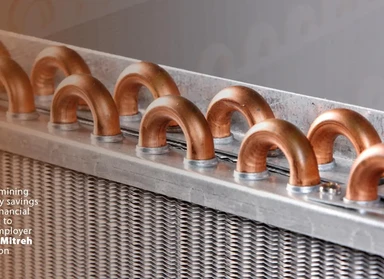Sediment control

Why is it important to control sedimentation and corrosion in desalination devices؟
Why is scale and corrosion control vital in desalination plants? A technical and economic analysis of the impact of scale and corrosion on equipment performance, cost, and life. Warning signs and preventive measures. Suitable for engineers and industrial managers

MED water desalination plant
MED (Multiple Effect Distillation) Desalination Plant — Comprehensive Guide to Chemical Requirements, Sediment and Corrosion Control with Solutions from Abrizan Company (Mitreh Brand). Specialized Chemical Washing, Thermal Anti-Sedimentation, Laboratory Consulting, Increased Efficiency — Reduced Energy Costs

Determining energy savings and financial return to the employer using Mitreh solution
One of the most important points in a heat exchanger is the overall heat transfer coefficient. This coefficient is obtained in terms of the conduction and convection resistances between the fluids separated by flat walls and cylindrical shells, respectively. The layer of scale on the surfaces may increase the resistance to heat transfer between the two fluids to a large extent. This effect can be taken into account by introducing an additional thermal resistance, called the fouling coefficient (Rf), and its value depends on the operating temperature, fluid velocity, and the operating time of the exchanger.

Introduction and application of antiscalants
Antiscalants are chemical compounds designed to prevent scale formation in water systems. By preventing scale formation on surfaces, these compounds can increase operational efficiency and reduce maintenance costs in industrial water treatment, oil and gas extraction, and desalination processes.

Physical and chemical descaling methods
In industries such as oil, gas and petrochemical, there is always an attempt to prevent the formation of deposits using different methods in equipment such as heat exchangers and boilers. In this field, a lot of money is spent on chemical materials and additives. But most industrial heat exchangers are exposed to sedimentation due to various reasons such as the low quality of water in different areas. These deposits are mostly formed in the pipes of the converters. In order to reduce the losses caused by sedimentation, the converter must be continuously monitored and cleaned.

Sediment formation in boilers
Boiler feed water should be free of hardness. Sometimes, due to the short or improper operation of the hardness device or the failure to regenerate the resins in time, some hardness enters the boiler feed water. Increasing the water temperature in the boiler reduces the solubility of water solutes. The water near the hot surfaces becomes saturated and the conditions for deposition of less soluble substances are provided and eventually sediment is formed.